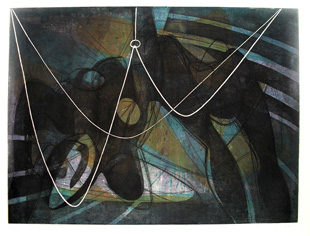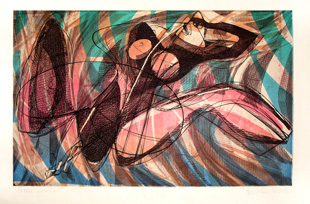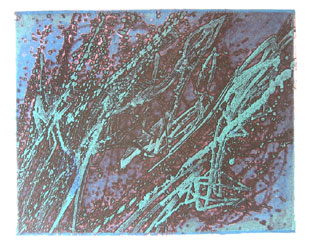HAYTER > Hayter Noyee Etching
Related Prints
This print is sold 

Etching, engraving, soft ground etching and scorper printed in colours on Rives paper, 1955, hand signed by Hayter, titled, numbered from an edition of 175 copies.
Printer : Atelier 17
Publisher : Oeuvre gravé.
Size of copper plate : 48 X 36 cm
Size of paper : 65 X 50 cm
Références Catalogue Black and Moorhead number 222
Marks of handling in the margins, subject is in good condition, very brillant and deep proof.
"La noyée from 1955, a striking and sombre print, combines the imagery of the 1940s with the successful colour experimentation of the 1950s ; the bold and flowing treatment of the looped white lines is particularly successful" (Desiree Moorhead in the preface of the catalogue raisonne). Other prints available by HAYTER
Printer : Atelier 17
Publisher : Oeuvre gravé.
Size of copper plate : 48 X 36 cm
Size of paper : 65 X 50 cm
Références Catalogue Black and Moorhead number 222
Marks of handling in the margins, subject is in good condition, very brillant and deep proof.
"La noyée from 1955, a striking and sombre print, combines the imagery of the 1940s with the successful colour experimentation of the 1950s ; the bold and flowing treatment of the looped white lines is particularly successful" (Desiree Moorhead in the preface of the catalogue raisonne). Other prints available by HAYTER
HAYTER : hayter-escoutay-etching
Original etching printed in colors, 1951, nice proof on Rives paper, signed, titled and annotated "essai couleurs" (trial colours proof) from an edition at 200 copies.
Printer : Hayter
Publisher : IGAS New-York.
Size of the paper : 38 X 49 cm.
Size of the etching : 20 X 31 cm.
References catalogue Moorhead number 200.
A few marks of handling in the paper, subject is in good condition.
"L'Escoutay heralds the beginning of a long series over many years of images inpired by light on moving water, many of which he conceived while watching the river Escoutay in Alba in the Ardèche where he bought a holiday house in 1951. The obsession with the water of the Escoutay deepened his interest in the representation of light and led to an increased brillancy of coulour in all media. The representation of the Escoutay's water, with its contrast of surfaces in shadow and direct sunlight, the movement of objects and force above, on and underneath its surface, provided Hayter with a motif that mirrored in certain important respects his representation of movement through air or space in recent work. In fact, water was even better suited pictorially to Hayter's imagination since it is a medium in which the movement of objects and forces leaves linear traces. This is also the period in which Hayters scientific training makes its first real impact on his imagery, in the form of linear (mathematical) representations of movement and especially in the early 1950s, figures represented by curves that suggest that they are in motion. The surreal, human drama of the prints of 1936 onwards comes slowly to an end in the mid 1950s. It was of such an intensity that one could hardly expect it to be sustained beyond the two decades witch it lasted. This was gradually superseded by more general, detached, landscape-based images which reflect more fully Hayters own interests in mathematics and science generally. (Peter Black in a text in the catalogue raisonne)
Original etching printed in colors, 1951, nice proof on Rives paper, signed, titled and annotated "essai couleurs" (trial colours proof) from an edition at 200 copies.
Printer : Hayter
Publisher : IGAS New-York.
Size of the paper : 38 X 49 cm.
Size of the etching : 20 X 31 cm.
References catalogue Moorhead number 200.
A few marks of handling in the paper, subject is in good condition.
"L'Escoutay heralds the beginning of a long series over many years of images inpired by light on moving water, many of which he conceived while watching the river Escoutay in Alba in the Ardèche where he bought a holiday house in 1951. The obsession with the water of the Escoutay deepened his interest in the representation of light and led to an increased brillancy of coulour in all media. The representation of the Escoutay's water, with its contrast of surfaces in shadow and direct sunlight, the movement of objects and force above, on and underneath its surface, provided Hayter with a motif that mirrored in certain important respects his representation of movement through air or space in recent work. In fact, water was even better suited pictorially to Hayter's imagination since it is a medium in which the movement of objects and forces leaves linear traces. This is also the period in which Hayters scientific training makes its first real impact on his imagery, in the form of linear (mathematical) representations of movement and especially in the early 1950s, figures represented by curves that suggest that they are in motion. The surreal, human drama of the prints of 1936 onwards comes slowly to an end in the mid 1950s. It was of such an intensity that one could hardly expect it to be sustained beyond the two decades witch it lasted. This was gradually superseded by more general, detached, landscape-based images which reflect more fully Hayters own interests in mathematics and science generally. (Peter Black in a text in the catalogue raisonne)
HAYTER : poissons volants, etching
Original etching printed in colours, 1958, very nice proof printed on a china paper, signed, dated and titled from an edition at 50 copies.
Printer : Atelier 17
Size of paper : 52 X 40 cm
Size of the print : 38 X 30 cm
Références catalogue Black et Moorhead n°248.
Good condition.
Original etching printed in colours, 1958, very nice proof printed on a china paper, signed, dated and titled from an edition at 50 copies.
Printer : Atelier 17
Size of paper : 52 X 40 cm
Size of the print : 38 X 30 cm
Références catalogue Black et Moorhead n°248.
Good condition.



